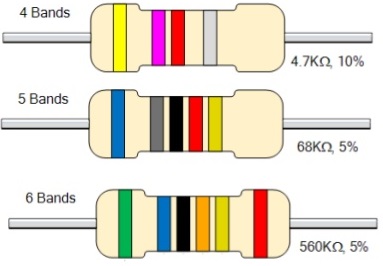

#100 ohms resistor color code code
For exampleįor more precision resistors, a four digit code is marked on them.


If the resistance is less than 10Ω then the letter R is used to indicate the position of the decimal point. In three digit coding, the first two numbers indicate the significant value of the resistance and the third number indicates the multiplier like 10 in case the digit is 1, 100 in case the digit is 2 or 1000 in case the digit is 3 and so on.Ī three digit coded SMD resistor is shown below There are three types of coding systems used to mark SMD Resistors. K and M should not be confused with kilo and mega Ohms. The letter code for tolerance is shown below The color code table for six band resistors is shown below Six Band ResistorColor Codeįor example if the colors on a six band resistor are in the order Orange, Green, White, Blue, Gold and Black then the resistance is calculated as 359 ×106± 5% 100 ppm/K = 359MΩ± 5% 100 ppm/K. But in some cases it may represent reliability and failure rate. Generally the sixth band represents temperature coefficient.This indicates that for a change of 10 0C in temperature, there can be a change of 0.1% in the value of resistance.The most common color used for sixth band is black which represents 100ppm/K.The rest of the bands are same as five band resistors.In case of high precision resistors, there is an extra band to indicate the temperature coefficient.The color code table for five band resistors is shown below.įor example, if colors on a five band resistor are in the order Red, Blue, Black, Orange and Gray then the value of resistance is calculated as 260×103± 0.05 = 260 KΩ ± 0.05%. Third band is used to indicate multiplier, fourth band is used for tolerance and fifth band is used to indicate the temperature coefficient with units of ppm/K.In this case, the first two bands indicate the two significant digits of resistance. There is an exception when the fourth band is either Gold or Silver.Fourth and fifth bands are used to indicate multiplier and tolerance respectively.The first three bands are used to indicate the first three significant values of resistance.The rest of the bands indicate the same things as four band color code. High precision resistors have an extra band which is used to indicate the third significant value of the resistance. The color code table for four band resistors is as shown below.įor example, if the colors on a four band resistor are in the order Green, Black, Red and Yellow then the value of resistance is calculated as 50 * 104± 2 % = 500KΩ± 2%. This gap helps in resolving the reading direction.

There is a significant gap between third and fourth bands.The fourth band is used to indicate tolerance.The third band is used to indicate the multiplier.The first two bands from the left are used to indicate the first and second significant digits of resistance.Four band color code is the most common representation in resistors.This means the resistance value lies in the region of 3760Ω to 5640Ω. The color code table corresponding to three band resistors is shown below.įor example if the colors on the resistor are in the order of Yellow, Violet and Red from left, then the resistance can be calculated as.The tolerance for three band resistors is generally 20%.The third band indicates the multiplier.The second band indicates the second significant number.The first band from the left indicates the first significant figure of the resistance.The three band color code is very rarely used.


 0 kommentar(er)
0 kommentar(er)
